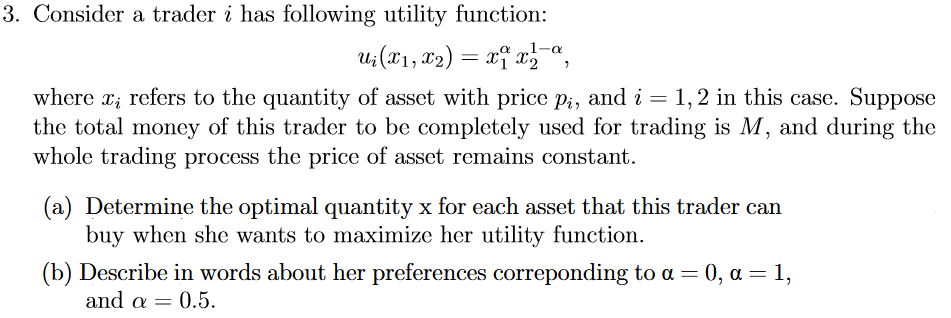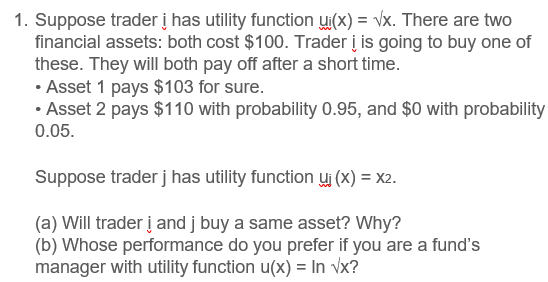Consider a trader i has following utility function: u;(x1, X2) = x† xª, 1-a where x; refers to the quantity of asset with price pi, and i = 1,2 in this case. Suppose the total money of this trader to be completely used for trading is M, and during the whole trading process the price of asset remains constant. (a) Determine the optimal quantity x for each asset that this trader can buy when she wants to maximize her utility function. (b) Describe in words about her preferences correponding to a = 0, a = 1, and α 0.5.
Consider a trader i has following utility function: u;(x1, X2) = x† xª, 1-a where x; refers to the quantity of asset with price pi, and i = 1,2 in this case. Suppose the total money of this trader to be completely used for trading is M, and during the whole trading process the price of asset remains constant. (a) Determine the optimal quantity x for each asset that this trader can buy when she wants to maximize her utility function. (b) Describe in words about her preferences correponding to a = 0, a = 1, and α 0.5.
Brief Principles of Macroeconomics (MindTap Course List)
8th Edition
ISBN:9781337091985
Author:N. Gregory Mankiw
Publisher:N. Gregory Mankiw
Chapter9: The Basic Tools Of Finance
Section: Chapter Questions
Problem 9PA
Related questions
Question
Hello, here are HW excercises I'm having trouble understanding.

Transcribed Image Text:3. Consider a trader i has following utility function:
u; (x1, 82) = xf x“,
1-a
where x; refers to the quantity of asset with price pi, and i = 1,2 in this case. Suppose
the total money of this trader to be completely used for trading is M, and during the
whole trading process the price of asset remains constant.
(a) Determine the optimal quantity x for each asset that this trader can
buy when she wants to maximize her utility function.
(b) Describe in words about her preferences correponding to a = 0, a = 1,
and α 0.5.

Transcribed Image Text:1. Suppose trader į has utility function ui(x) = vx. There are two
financial assets: both cost $100. Trader į is going to buy one of
these. They will both pay off after a short time.
• Asset 1 pays $103 for sure.
• Asset 2 pays $110 with probability 0.95, and $0 with probability
0.05.
Suppose trader j has utility function uj (x) = x2.
(a) Will trader į and j buy a same asset? Why?
(b) Whose performance do you prefer if you are a fund's
manager with utility function u(x) = In vx?
Expert Solution
This question has been solved!
Explore an expertly crafted, step-by-step solution for a thorough understanding of key concepts.
Step by step
Solved in 2 steps

Knowledge Booster
Learn more about
Need a deep-dive on the concept behind this application? Look no further. Learn more about this topic, economics and related others by exploring similar questions and additional content below.Recommended textbooks for you

Brief Principles of Macroeconomics (MindTap Cours…
Economics
ISBN:
9781337091985
Author:
N. Gregory Mankiw
Publisher:
Cengage Learning

Essentials of Economics (MindTap Course List)
Economics
ISBN:
9781337091992
Author:
N. Gregory Mankiw
Publisher:
Cengage Learning


Brief Principles of Macroeconomics (MindTap Cours…
Economics
ISBN:
9781337091985
Author:
N. Gregory Mankiw
Publisher:
Cengage Learning

Essentials of Economics (MindTap Course List)
Economics
ISBN:
9781337091992
Author:
N. Gregory Mankiw
Publisher:
Cengage Learning
